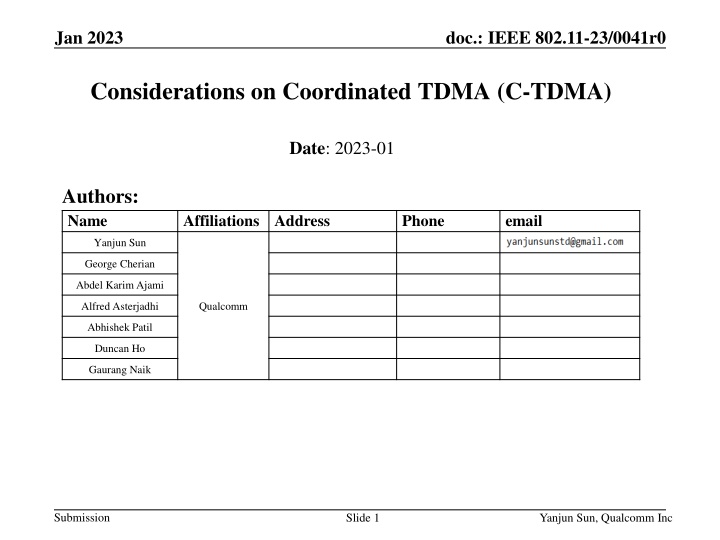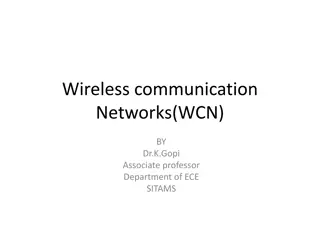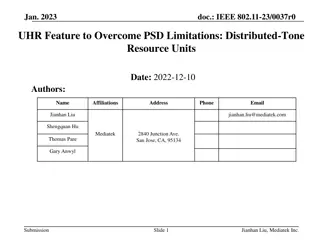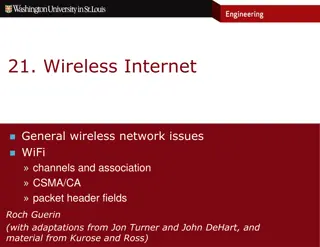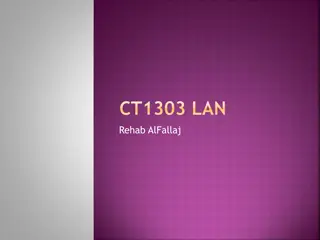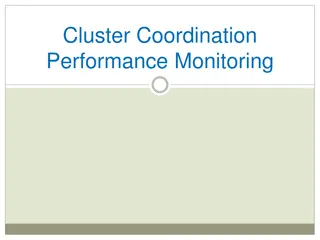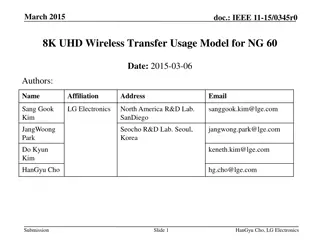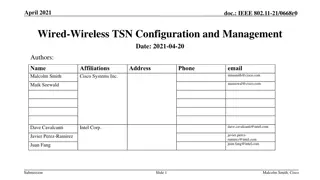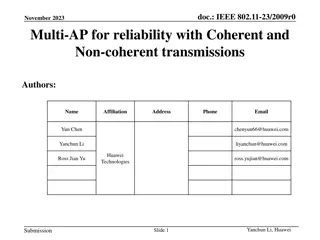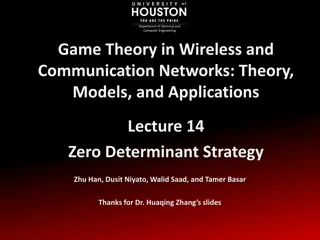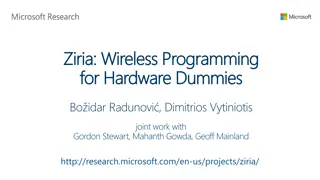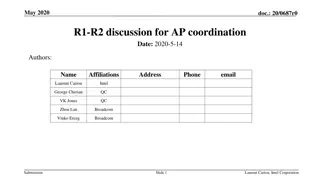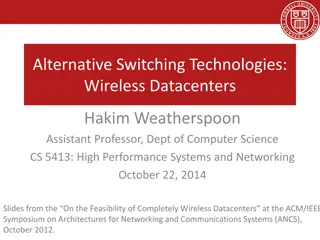Enhancing AP Coordination for Improved Wireless Network Performance
This document discusses considerations for Coordinated TDMA (C-TDMA) in IEEE 802.11 networks to address issues of limited coordination among Access Points (APs). The objective is to enhance coordination among APs to improve network reliability in terms of latency, throughput, and fairness. Design principles focus on simplifying signaling and architecture while minimizing complexity and overhead. The system model inherited from previous discussions outlines key aspects of AP coordination. Additional system requirements, such as operational flexibility and support for different types of devices, are also considered for C-TDMA implementation.
Download Presentation

Please find below an Image/Link to download the presentation.
The content on the website is provided AS IS for your information and personal use only. It may not be sold, licensed, or shared on other websites without obtaining consent from the author.If you encounter any issues during the download, it is possible that the publisher has removed the file from their server.
You are allowed to download the files provided on this website for personal or commercial use, subject to the condition that they are used lawfully. All files are the property of their respective owners.
The content on the website is provided AS IS for your information and personal use only. It may not be sold, licensed, or shared on other websites without obtaining consent from the author.
E N D
Presentation Transcript
Jan 2023 doc.: IEEE 802.11-23/0041r0 Considerations on Coordinated TDMA (C-TDMA) Date: 2023-01 Authors: Name Affiliations Address Phone email Yanjun Sun George Cherian Abdel Karim Ajami Alfred Asterjadhi Qualcomm Abhishek Patil Duncan Ho Gaurang Naik Submission Slide 1 Yanjun Sun, Qualcomm Inc
Jan 2023 doc.: IEEE 802.11-23/0041r0 Problem Statement Problem: existing 802.11 offers limited coordination among APs, which can lead to long latency, low throughput and unfairness Objective: enhance coordination among APs in time to improve the reliability of the network in latency, throughput and fairness [1][2] Submission Slide 2 Yanjun Sun, Qualcomm Inc
Jan 2023 doc.: IEEE 802.11-23/0041r0 Design Principles Some motions related to AP coordination have already passed in EHT UHR should consider them for AP coordination Some hooks (e.g. Triggered TXOP Sharing (TXS)) have been introduced in EHT for TXOP sharing UHR design should be built on top of the existing hooks AP coordination scheme should be kept simple in signaling and architecture The scheme should minimize signaling complexity, overhead, and required changes on the APs Submission Slide 3 Yanjun Sun, Qualcomm Inc.
Jan 2023 doc.: IEEE 802.11-23/0041r0 System Model (Inherited from EHT Discussions) A sharing AP (TXOP Owner) is in range with a shared AP (AP to which part of the TXOP is shared) [3] No backhaul coordination between APs assumed However, backhaul signaling is not prohibited, which can be used to avoid some over-the-air signaling Protocol does not assume that two shared APs are in range with each other The sharing AP and the shared AP belong to a same AP candidate set [4]; no pre-assigned Master AP or pre-assigned AP groups Any AP may become a sharing AP when it wins a TXOP A sharing AP and a shared AP may have different primary channels [5][6] Expect at least one subband is common between sharing and shared APs A client of a shared AP may not be in range of the sharing AP Following slides focuses on C-TDMA as an example to explore potential challenges/solutions Submission Slide 4 Yanjun Sun, Qualcomm Inc.
Jan 2023 doc.: IEEE 802.11-23/0041r0 Other Systems Requirements to Consider for C-TDMA Flexibility in operating channel configuration Same or different operating channel widths, in addition to different primary channels Capability in handling uplink traffic from legacy HE/EHT STAs Support of HE/EHT/UHR STAs VS support of UHR STAs only Simplicity in signaling and architecture TXOP allocated to a single shared AP (similar to EHT TXS) VS TXOP allocated to multiple shared APs Processing delay at a sharing AP: flexible responding delay (similar to HE/EHT padding) VS fixed/fast responding delay Submission Slide 5 Yanjun Sun, Qualcomm Inc.
Jan 2023 doc.: IEEE 802.11-23/0041r0 Discussion on Operating Channel Configurations AP1 AP2 Observations APs may have different primaries [5][6] and BW in a deployment: Same bandwidth Fully overlap Partial overlap (320 MHz only) Different bandwidths One channel is a subset of the other channel P20 P20 P20 320M Hz P20 P20 320M Hz UHR group needs to consider a C-TDMA protocol that handles APs with different operating channel configurations Potential solution: Use non-HT dup PPDU for control signaling to reach a shared AP, assuming the AP s primary channel is within the operating channel width of the sharing AP. P20 P20 Submission Slide 6 Yanjun Sun, Qualcomm Inc.
Jan 2023 doc.: IEEE 802.11-23/0041r0 Uplink Traffic from Legacy HE/EHT STAs Observations: HE/EHT STAs are expected to be around during the rollout of UHR APs Many types of latency traffic are bidirectional in nature Uplink traffic can be dominant in some use-cases (E.g. stadium) Problem: if NAV is set by a sharing AP, an HE/EHT STA associated with a shared AP cannot send uplink data C-TDMA protocol needs to allow uplink traffic from legacy HE/EHT STAs to a shared AP during a TXOP shared to the AP Potential solution: The sharing AP doesn t set the NAV for the whole TXOP in the beginning and set it incrementally instead Submission Slide 7 Yanjun Sun, Qualcomm Inc.
Jan 2023 doc.: IEEE 802.11-23/0041r0 Reuse the EHT TXS framework? Observations: TXS can already allocate a TXOP to an associated device In UHR, TXS may be expanded to allocate TXOP to a neighboring AP The UHR group should try to maximize the reuse of the existing TXS framework to allow a sharing AP to allocate its TXOP to a neighboring AP by some extension of the TXS framework Submission Slide 8 Yanjun Sun, Qualcomm Inc.
Jan 2023 doc.: IEEE 802.11-23/0041r0 Simplicity (1/2) Observations: A TXS Trigger frame allocates TXOP to a single STA (i.e. one User Info field) at a time in EHT Even with such simplification, failure recovery and TXOP return are already complex Allocation to multiple shared APs is expected to introduce more complexity and signaling overhead when carried in OTA messages Recommendation: For simplicity, the UHR group should allow a mode where TXOP is shared with only one shared-AP In addition, the UHR group may study the tradeoff of sharing the TXOP with more than one shared-APs Submission Slide 9 Yanjun Sun, Qualcomm Inc.
Jan 2023 doc.: IEEE 802.11-23/0041r0 Simplicity (2/2) Observations: To handle different responding delays due to different architectures, the non-AP STA can use Trigger Frame MAC Padding Duration (MinTrigProcTime) to buy more processing delay Similarly, UHR APs may need different processing delays as well, in order to account not only for the difference in architectures, but also for more complex scheduling decisions and higher workload at an AP (e.g. the processing delay may depend on number of STAs and workload at the AP) Recommendation: A sharing AP needs to accommodate the different processing delay requirements of shared APs Submission Slide 10 Yanjun Sun, Qualcomm Inc.
Jan 2023 doc.: IEEE 802.11-23/0041r0 Summary We had a recap on CAP system model from EHT and discussed the following systems requirements for C-TDMA in UHR: Flexibility in operating channel configuration C-TDMA protocol should work with APs that have different operating channel configurations (i.e. different primary channels and bandwidths) Capability in handling uplink traffic from legacy HE/EHT STAs C-TDMA should allow uplink traffic from legacy HE/EHT STAs to a shared AP during a TXOP shared to the AP Simplicity in signaling and architecture UHR should maximize the reuse of the existing TXS framework UHR should allow a mode where TXOP is shared with only one shared-AP. In addition, the group may study the tradeoff of sharing the TXOP with more than one shared-APs A sharing AP needs to accommodate the different processing delay requirements of shared APs Submission Slide 11 Yanjun Sun, Qualcomm Inc.
Jan 2023 doc.: IEEE 802.11-23/0041r0 Reference [1] George Cherian and et al. (Qualcomm), Coordinated AP Time/Frequency Sharing in a Transmit Opportunity in 11be , 19/1582r2, November 2019. [2] George Cherian and et al. (Qualcomm), Coordinated AP Time and Frequency Sharing Gain Analysis , 19/1879r0, November 2019. [3] Sungjin Park and et al. (LGE), Setup for Multi-AP coordination, 19/1895r2, January 2020. [4] Cheng Chen and et al. (Intel), Multi-AP group formation follow-up , 19/1931r2, January 2020 [5] Po-Kai Huang and et al. (Intel), Multi-AP configuration and resource allocation, 20/0560r0, April 2020. [6] Arik Klein and et al. (Huawei), Thoughts on M-AP Coordination Principles , 22/1895r0, December 2022. Submission Slide 12 Yanjun Sun, Qualcomm Inc.
Jan 2023 doc.: IEEE 802.11-23/0041r0 APPENDIX Submission Slide 13 Yanjun Sun, Qualcomm Inc.
Jan 2023 doc.: IEEE 802.11-23/0041r0 Related Motions from EHT Define a procedure for an AP to share its frequency/time resources of an obtained TXOP with a set of APs. Set of APs is TBD. [Motion 56] An EHT AP which obtains a TXOP and initiates the multi-AP coordination is the sharing AP. An EHT AP which is coordinated for the multi-AP transmission by the sharing AP is the shared AP. NOTE The name of the sharing AP and the shared AP can be modified. [Motion 73] 802.11be supports the following: Sharing AP and shared AP may not have the same primary 20 MHz channel. The primary 20 MHz channel of the shared AP shall be within the BSS operating channel width of the sharing AP. The primary 20 MHz channel of the sharing AP shall be within the BSS operating channel width of the shared AP. [Motion 119] 802.11be shall define an AP candidate set* as follows: An AP candidate set is a set of APs that can initiate or participate in multi-AP coordination. An AP in an AP candidate set can participate as a shared AP in multi-AP coordination initiated by a sharing AP in the same AP candidate set. At least one AP in an AP candidate set shall be capable of being a sharing AP. NOTE The name* can be changed. [Motion 124] Source DNC: 20/1935r66 Submission Slide 14 Yanjun Sun, Qualcomm Inc.
